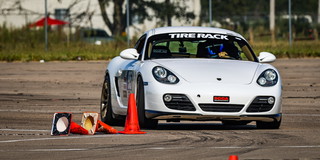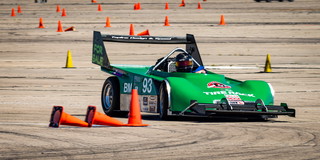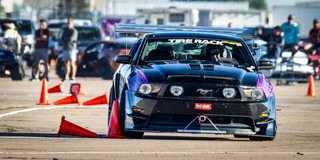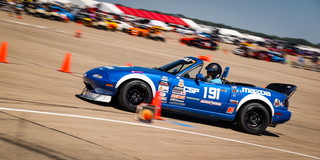
This article first appeared in the March, 2016 edition of SportsCar Magazine. SCCA members can read the current and past editions of SportCar digitally here after logging into their account; To become an SCCA member and get SportsCar mailed to your home address monthly in addition to the digital editions, click here.
Are your brakes turning against you? We take a closer look at the most abused part of your racecar
OEM brake technology constantly improves, but that never stops SCCA members from exceeding the capabilities of those components. From your dual-purpose, daily driven Solo car to your dedicated track toy or tow rig, we make a hobby of abusing our brakes every chance we get. Luckily, there are tricks to maximizing the life of your brakes.
On the track, we’ve seen drivers enter the pits on a hot lap to collect hot tire temperature and pressure data. While useful for chassis tuning, eliminating the cool down lap is stressful on brake components. In a similar fashion, setting the parking brake after a run on the Solo course is just as painful to your brakes. Then there are the weekend warriors towing down the highway to an event, but still driving the loaded truck as if it were empty.
So, how do you know your brakes are starting to go? According to Ian Berwick, Motorsports Manager USA for Pagid Racing, you might experience judder or brake fade. “Brake judder, which is usually a surface variation that people think of as warped rotors, is most commonly from imprinting,” he explains. “The imprinting is usually taking pad material out of the disc surface. Imprinting occurs when someone parks the car on pit lane and stands on the brakes. It’s putting all the pressure on the pad, which basically welds the pad material in the pad to the material embedded on the rotor – when you release the brakes, it kind of breaks the material free, essentially removing the surface layer from the rotor, leaving a low spot. Now that area of the rotor needs to be bedded again.”
Fade is very different. “Pad fade occurs when the compound is subjected to temperatures above its effective operating range,” says Wilwood Engineering’s Carl Bush. “The pedal remains firm, but the pads lose friction and the vehicle no longer decelerates properly. Pad fade is often referred to as glaze.”
Brake pads can also suffer catastrophic failures. “Brake pad delamination usually comes from a poor retention mechanism holding the brake pad to the backing plate,” says Berwick. “A lot of companies use a boundary layer, or an adhesive layer, and they have big holes in the backing plate, and the pad keys into that. We intentionally avoid that, because we don’t think it works very well – we use brass pins that are welded to the backing plate that reinforce the pad so it can’t separate from the plate.”
Excessive pad wear also results when pads are subjected to sustained temperatures at the peak of their effective operating range, Bush tells us. “The pads may not be glazing and losing friction, but they may no longer be capable of surviving the event,” he says.
Brake damage is costly once it has occurred because you’re often left replacing parts. “There isn’t really a way to repair judder,” says Berwick. “You can try to re-bed the pads, but this often doesn’t work. On a street car, you can try having the rotors turned, but in a race application, you will need to replace the rotors.”
There are tricks to keeping your brakes in tip-top condition. For example, to measure tire temperatures, don’t save it for the last lap of the track session; do it at a time that will allow you to go back on track and give the car a proper cool down lap. Likewise, as you return to the paddock from a Solo run, use wheel chocks as an alternative to the handbrake. And, finally, as you exit the freeway with your tow rig, stop short of that red light, allowing yourself room to move up so you’re not focusing all of the pad’s heat in one spot.
If you’re simply driving beyond what the pads are capable of, that’s an easy fix as well. “The fix is upgrading to a pad with a higher effective temperature range that will produce a longer wear rate,” says Bush. “Preventing pad fade simply requires a pad upgrade to a material with a higher effective operating range.”
Once you’ve selected your pads, don’t skip the bed-in process. Hawk Performance advises adequate bedding to optimize a pad’s performance, durability, and lifespan.
But brake failures come in many shapes and sizes, and sometimes the solution comes in the form of better parts. Multi-time Runoffs Champ Andy McDermid suffered a catastrophic rotor failure at the 2014 SCCA National Championship Runoffs at Mazda Raceway Laguna Seca. “The left front rotor failed on lap four of the race at the Runoffs – the last 16 laps were not fun,” says McDermid. “It was a two-piece rotor – the rotor failed; it was a manufacturing issue.”
A total rotor failure is the extreme of what most of us will experience. Most failure will come in a less catastrophic form. “Distortion or warping can occur for a number of reasons,” says Bush. “Overall, mass or weight, the specific metallurgy of the alloy being used, and the uniformity and quality of the alloy and casting itself, can all contribute to thermally induced distortion or resistance against it.”
The Fix? “Either better quality rotors, or improved heat management to maintain a more stable temperature range during brake cycles,” says Bush.
Back to McDermid’s tale of woe, his solution was along similar lines. “We have made a complete system change,” he says. “We are using Brembo rotors and calipers from Pro System Inc. The Pro System Inc. Brembo-prepped rotors and calipers in concert with Carbotech pads have been perfect. The combination has helped shorten our braking distance, and we are able to get two to three weekends out of a set of front rotors, compared to one or two sessions on the old brand.”
Beyond all of this, brake maintenance is also essential. “Regardless of the durability of each individual component, neglecting routine maintenance is the easiest way to realize on-track failures and DNFs,” says Bush. “A routine maintenance plan should include inspection of the entire brake system between each event. Pads should be checked for wear and damage. Rotors should be checked for cracks and non-uniform surface conditions such as pad smear.” Bush also notes that calipers should be bled and fluid levels topped off, with some vehicles requiring this between sessions. But with a little bit of determination, keeping your brake system up and running isn’t that hard – just remember to never take your brakes for granted.
Words by Jason Isley
Photo by Rick Corwine














